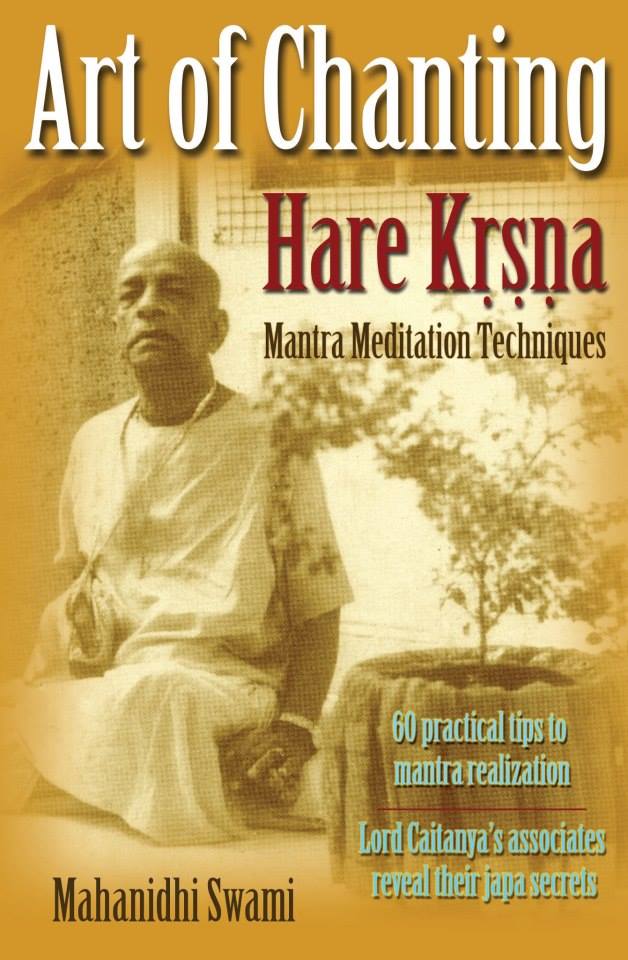Mahanidhi Madan Gopal Das
Gopala Guru Gosvami, a disciple of Vakresvara Pandita and the guru of Dhyanacandra Gosvami, lived five hundred years ago in Jagannatha Puri where He regularly associated with Sri Caitanya Mahaprabhu. The following is a translation of his commentary on the Hare Kṛṣṇa maha-mantra:
Hare–Just as fire automatically burns an object on contact, the transcendental name of Hari takes away (harati) or burns up all the sins of materialistic people. It removes (harati) all ignorance and reveals the transcendental, blissful form of the Lord. Hari means that dazzling personality who attracts (harati) the minds of everyone in the universe when they hear about His divine qualities. Hari’s ever-youthful sweet, beautiful form enchants the mind of millions of kamadevas (Cupids). The vocative form of Hari is Hare.
The word Hare also indicates Hara or Srimati Radhika, the daughter of Vrsabhanu, who steals (harati) the mind of Hari during the rasa dance by Her beautiful form and affectionate love. The vocative form of Hara is Hare.
Kṛṣṇa–The word ‘Kṛṣṇa’ is composed of the root kṛṣ meaning all-attractive and na meaning supreme bliss. Combined they form the word ‘Kṛṣṇa’ which signifies the all-attractive, supremely blissful Supreme Personality of Godhead, Sri Kṛṣṇa. Nandanandana, Sri Govinda, who has lotus eyes and a dark blue complexion, is the only source of bliss for the Vrajavasis.
Rama–The word ‘Rama’ indicates “ramante” the embodiment of unlimited pleasure. Sri Kṛṣṇa, who is the topmost expert in loving affairs and the worshipable Deity of amorous pastimes, always enjoys Radha. He is therefore called Rāma (Rādhāramaṇa Rāma).
Lord Siva said, “Hey Parvati! All sins flee from the body just by pronouncing the first syllable of the word “Rama” (ra). And upon chanting the syllable (ma), the door of the mouth closes to prevent their reentrance.”
Hare–Because Radha steals the mind of Kṛṣṇa, She is called Hara (Hare in the vocative).
Kṛṣṇa–Because Kṛṣṇa attracts Radha’s mind, He is called Kṛṣṇa.
Hare–Because Radha takes away Kṛṣṇa’s modesty, sobriety and patience, She is called Hara.
Kṛṣṇa–He whose attraction makes Radhika lose all Her shyness and patience is called Kṛṣṇa.
Kṛṣṇa–Wherever Sri Radha stands or goes, She sees Kṛṣṇa touching Her, forcibly pulling Her bodice and attracting Her. Therefore He is known as Kṛṣṇa.
Kṛṣṇa–By playing His seductive flute, He pleases Radhika and draws Her into the forest of Vrndavana. For this reason, He is called Kṛṣṇa.
Hare–In every direction Kṛṣṇa moves or stands, He sees Radha standing before Him. For captivating Kṛṣṇa’s consciousness in this way, Radhika is called Hara (Hare in the vocative).
Hare–Because Radhika takes Kṛṣṇa away by forcing Him to meet Her in a secret place, She is addressed as Hare.
Hare–Sri Radhika forcibly attracts Sri Kṛṣṇa into the forest of Vrndavana. Therefore, She is called Hara (Hare in the vocative).
Rama–Kṛṣṇa’s smile, glance and laughter delight the heart of Radha. For this reason, Kṛṣṇa is called Rama.
Hare–The association of Sri Radha makes Kṛṣṇa immediately lose His patience and composure. For this, She is known as Hara (Hare in the vocative).
Rama–Sri Kṛṣṇa enjoys Srimati Radharani by kissing, embracing and touching Her breasts. Thus He is called Rama.
Rama–Kṛṣṇa enjoys conjugal pastimes with Sri Radha by making Her play the dominant role in love. Therefore, Kṛṣṇa is known as Rama.
Rama–Because Kṛṣṇa repeatedly enjoys such love sports, He is called Rama.
Hare–At the end of the rasa dance, Radhika captures Kṛṣṇa’s mind and goes away. Thus She is addressed as Hara (Hare in the vocative).
Hare–Kṛṣṇa also captures Radhika’s mind after the rasa dance and goes away. For this, He is called Hari (Hare in the vocative).
An excerpt from the book Art of Chanting

